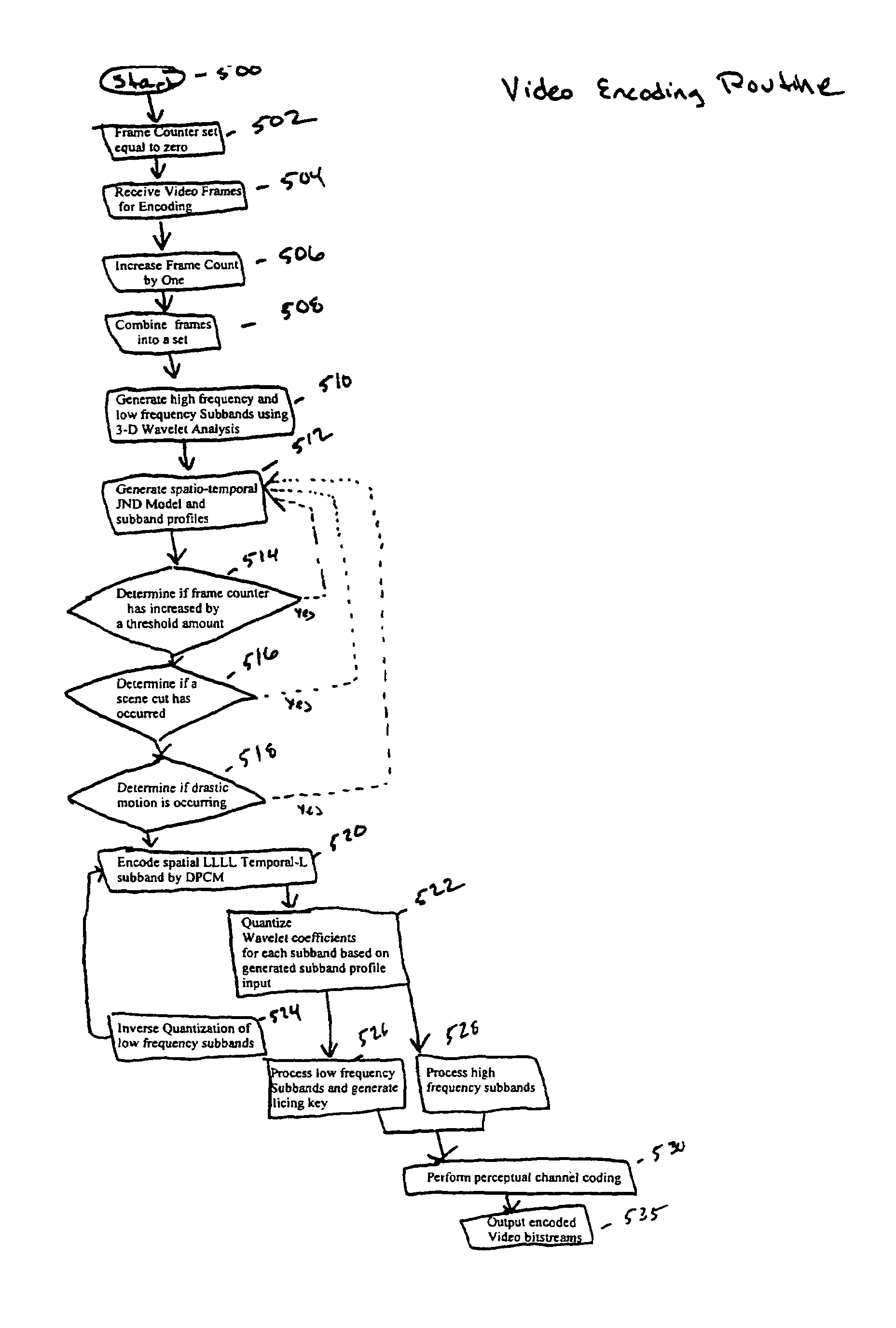3D wavelet based video codec with human perceptual model
a human perceptual model and video codec technology, applied in the field of compression and encryption of data, can solve the problems of encoding these signals with the lowest possible bit rate, reducing the overall bandwidth available for transmitting video and audio signals, and increasing the power of such systems
- Summary
- Abstract
- Description
- Claims
- Application Information
AI Technical Summary
Benefits of technology
Problems solved by technology
Method used
Image
Examples
example 1
[0103]Assume the source symbol frequency model is [ 0120.30.30.4]
which indicates that Prob(symbol=0) is 0.3, Prob(symbol=1) is 0.3. Prob(symbol=2) is 0.4. The source sequence for AC encoding is[0104]1 1 1 2 0 2 0 1 0 1 0 1 2 2 1 0 0 2 1 0
The encoded binary bit stream is[0105]10010000 10010001 01000110 11100100 11 (34 bits)
Here the frequency model doesn't match the distribution of source sequence. But it only decreases the compression ratio and doesn't change the characteristics of AC. If the third symbol 1 is replaced by 2 and 0 respectively, the encoder will give out the corresponding binary bit stream[0106]10001000 00011000 10011011 01000101 1 (33 bits) and[0107]10010111 01111010 11010100 01100011 00 (34 bits)
[0108]Only a few bits in the front are the same in these three cases. The numbers of output bits are also different, i.e., the change of the previous symbol changes the encoding of the following symbols completely.
[0109]The loss of source symbol also diversifies the encoding ...
example 2
[0112]Assume the same symbol frequency model as that in the previous case.
The sequence of symbols for encoding is
[0113]1 2 2 0 2 0 1 0 1 0 1 2 2 1 0 0 2 1 0 1
The encoding output is[0114]01110000 01010011 10110001 11110010 01 (34 bits)
[0115]Suppose there is one bit (7th bit) error in the bit stream, which turns it into[0116]01110010 01010011 10110001 1111001001.
Then the decoded symbol sequence is[0117]1 2 2 0 0 1 0 0 2 2 1 0 2 0 2 2 2 0 2 0
The symbols after the 3rd one are totally different from the original symbols.
[0118]If the decoder erroneously locates the start bit position in the bit stream, the following symbols cannot be decoded correctly since in both cases the decoding path in the tree structure is misled.
Input symbol sequence:
[0119]1 2 2 0 2 0 1 0 1 0 1 2 2 1 0 0 2 1 0 1
Output bit stream after encoding:[0120]01110000 01010011 10110001 11110010 01 (34 bits)
1 bit left shift:[0121]11100000 10100111 01100011 11100100 1
Output symbol sequence after decoding:[0122]0 1 1 0 2 0 1 2...
PUM
 Login to View More
Login to View More Abstract
Description
Claims
Application Information
 Login to View More
Login to View More - R&D
- Intellectual Property
- Life Sciences
- Materials
- Tech Scout
- Unparalleled Data Quality
- Higher Quality Content
- 60% Fewer Hallucinations
Browse by: Latest US Patents, China's latest patents, Technical Efficacy Thesaurus, Application Domain, Technology Topic, Popular Technical Reports.
© 2025 PatSnap. All rights reserved.Legal|Privacy policy|Modern Slavery Act Transparency Statement|Sitemap|About US| Contact US: help@patsnap.com



